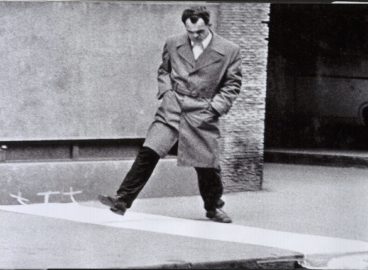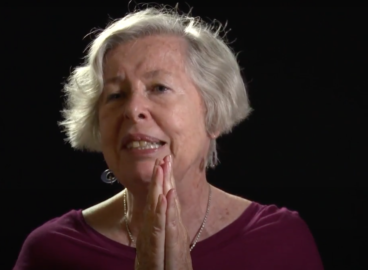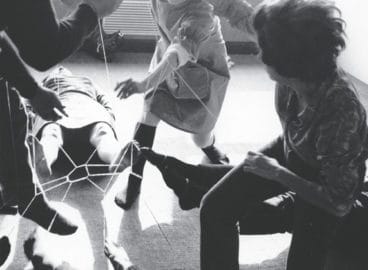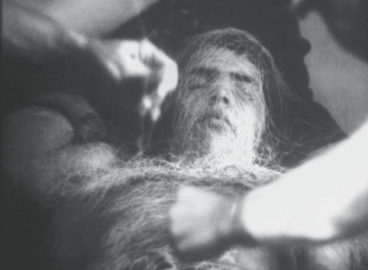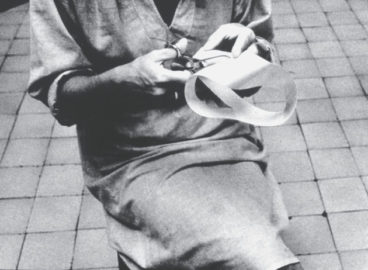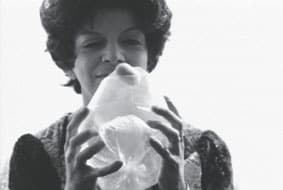In the mid-1960s, Brazilian artist Lygia Clark turned from painting and sculpture to make participatory “proposições” (propositions). In the 1970s, she started “corpo coletivo” (collective body) experiments. Scholar and curator André Lepecki considers why the artist so adamantly refused to call these works performance art in this essay, which considers how Clarke’s art ventured beyond performance through a disregard for traditional borders between audience and performer.
In addition to Lepecki’s essay, you can access installation views and the press release through MoMA’s online exhibition history archive here.

Accept the provisional since the process can never stop.
—Lygia Clark, “Letter to my son,” c. 1970
This sensation of precariousness, of being absorbed in the immanence of the act of discovering the sense of existing.
—Lygia Clark, “Capturar um Fragmento de Tempo Suspenso” (To capture a fragment of suspended time), 1973
Lygia Clark and Performance
At first glance, Lygia Clark’s relationship to performance seems a simple matter: when she moved from painting and sculpture to what she called her participatory “proposições” (propositions) of the mid-1960s,1Lygia Clark’s first participatory works are the manipulable metal sculptures Bichos (Critters, 1960–63) and her first groundbreaking proposition is Caminhando (Walking, 1963). On the latter, the critic Mário Pedrosa wrote, “The artist abdicates from realization, since she transfers to the other, the spectator, the task of making.” Pedrosa, “A Obra de Lygia Clark,” 1963, in Otília Arantes, ed., Académicos e Modernos. Textos Escolhidos III(São Paulo: USP Editora, 1998), p. 352. Author’s trans. and when she started her “corpo coletivo” (collective body) experiments in the 1970s,2Clark, “O Corpo Coletivo,” n.d., in Lygia Clark, exh. cat. (Barcelona: Fundació Antoni Tapiès, 1998), p. 306. she adamantly refused to allow these works to be called performance art, or for that matter Happenings or body art, the other major forms of live visual art as consolidated at the time. The critic and curator Guy Brett, who met the artist in the mid-1960s and has written on her extensively, notes that throughout her career, “Clark distinguished her work from many forms of ‘body art’ and ‘performance.’”3Guy Brett, “Life Strategies: Overview and Selection,” in Russell Ferguson, ed., Out of Actions: Between Performance and the Object, 1949–1979, exh. cat. (Los Angeles: The Museum of Contemporary Art, 1998), p. 216. The art historian Yve-Alain Bois, who also met Clark in the 1960s, when he was still a teenager, witnessed a meeting between her and a European curator in 1973. “Thinking he could categorize Lygia’s work, he made the mistake of referring to ‘Body Art’ (particularly to the masochistic scenes of Gina Pane), and to Happenings.” Clark’s response was “a torrent of furious abuse: her work had nothing to do with any performance whatsoever nor with the offering on a platter, for the secondary benefit of a voyeur, of her fantasies and impulses.”4Yve-Alain Bois, “Nostalgia of the Body,” October69 (Summer 1994):87–88.
Others besides Clark differentiated her work from performance and body art. Her singularity in using propositions to assemble and mobilize bodies, participants, and live action, her “unprecedented orientation for the issues of her time,” were obvious to those following the development of her practices.5Suely Rolnik, “Molding a Contemporary Soul: The Empty-Full of Lygia Clark,” in Susan Martin and Alma Ruiz, eds., The Experimental Exercise of Freedom: Lygia Clark, Gego, Mathias Goeritz, Hélio Oiticica, Mira Schendel, exh cat. (Los Angeles: Museum of Contemporary Art, 1999), p. 61. In a letter to Clark of December 11, 1967, Brett drastically distinguished her experiments from “other things I have seen by other people in Europe and America vaguely related to what you are doing—in happenings and so on.” Compared to Clark’s experiments, the latter seemed to him “like choreography, mere effect” (emphasis mine).6Brett, letter to Lygia Clark, December 11, 1967. Archives of the Associação Cultural “O Mundo de Lygia Clark,” Rio de Janeiro. What was Clark doing in the mid-1960s that would prompt Brett to describe North American and European Happenings as by comparison “mere effect”? What was she doing in 1973 that could make her fly into a fury when a well-informed and well-meaning curator aligned her work with the booming performance-art scene of the day?

In 1963, Clark made a fundamental discovery. Having critiqued the flat support of painting in her 1960 text “The death of the plane,”7Clark, “A morte de plano,” 1960. Eng. trans. in October 69 (Summer 1994). having rejected the passive objecthood of sculpture in creating the small manipulable three-dimensional works of the Bichos series (Critters, 1960–63), she would take her views to their logical conclusion: it was the artwork itself, along with the very notion of the artist, that had to be superseded. To reach this double goal of “achiev[ing] the anonymous work” and of “the artist dissolv[ing] in the world,” she devised her first “proposition” for an “act” to be carried out by a “participant.”8Clark, “On the Magic of the Object,” 1965, in Lygia Clark, exh. cat. (Barcelona: Fundació Antoni Tapiès, 1998), p. 153. She called the work Caminhando. Anyone can “make for oneself” a Caminhando, Clark wrote in 1964: take a strip of paper, twist it once, glue the ends together to form a Möbius strip, pick up a pair of scissors, and cut the strip along its length without ever fully severing it—an exercise of concentration, commitment, and continuous choice. Clark’s discovery that carrying out a propositional act without an audience produced an artwork that was not an object but an always singular, always provisional expression of a commitment would have deep repercussions for her future practice. From this point on, she would “attribute an absolute importance to the immanent act carried out by the participant.”9Clark, “Caminhando,” 1964, in ibid., p. 151.


The Argentinean artist Lea Lublin, who became friendly with Clark in Paris in the late 1960s, has remarked that Clark “never took her own body as the support for her work.”10Lea Lublin, interview in the archives of the Associação Cultural “O Mundo de Lygia Clark.” Her withdrawal of her body’s presence, and her ending of the dichotomy between work and audience, indicate that what was emerging in Caminhando was something other than performance. It is in this sense that Clark’s propositional works differed from much of the performance art seen in Paris (Clark’s city of choice throughout the mid-1960s and early 1970s) and elsewhere, from Jean-Jacques Lebel’s first Happenings in 1960, to works such as Carolee Schneeman’s Meat Joy, which debuted in the first Festival de la Libre Expression in 1964, to Lublin’s Mon Fils (My son), performed at the Musée d’Art Moderne de la Ville de Paris in 1968 — the occasion on which Lublin met Clark. Determining all of Clark’s propositional works to come would be what she discovered in Caminhando: that the point was not to create an event for an audience, and to use the artist’s actions and body as the object of contemplation (or even worse, as the object of admiration), but to invite everyone to experience his or her own body as an agent of choice, in an open process of discovery immanent to the performance of an act.11Paulo Herkenhoff stresses the political resonances of choice and agency in Caminhando: “Under the military dictatorship of ’64, Clark presents art as a decision-making model and as a model of subjectivation.” Herkenhoff, quoted in Rolnik, De l’oeuvre à l’événement, exh. cat. (Nantes: Musée des Beaux-Arts, 2005), p. 85. Author’s trans. Caminhando brought Clark to understand that through the proposition she could generate a crucial divorce between artwork and artist, elements that performance art and particularly body art tended to conflate. Consider a work contemporary to Caminhando, also involving scissors, Yoko Ono’s Cut Piece(1964): Ono sat still on a stage, under theatrical lighting that made her body the object of the audience’s undivided attention, and invited viewers to cut off her dress, fusing their participation with a sense of violence and violation. Here the artist’s body was both object and support, something Clark would directly go against, as we will see. The difference in each artist’s approach to action, art, participation, and the artist’s own body could hardly be greater.

After Caminhando Clark went through what she called a “regression” to form.12Clark writes that “compared to Caminhando [the soft objects Trepantes] looked like a regression, a return to the object.” Clark, “Capturar um Fragmento de Tempo Suspenso,” 1973, in Lygia Clark (Barcelona), p. 187. Author’s trans. She needed time to digest the radicality of Caminhando’s destruction of the artwork as object, its replacement of the art object with an “immanent act” performed not by an artist but by a “participant,” and in a nonartistic context. For three years she created soft sculptures, the Trepantes (Climbers), but in 1966 her research led to a whole series of Objetos sensoriais (Sensorial objects), eventually to be joined under the title Nostalgia do corpo (Nostalgia of the body). These objects became the catalysts of participatory propositions involving precarious, cheap, or quotidian materials (elastic bands, plastic bags, onion or orange sacks, pebbles, water, rubber tubes, etc.). Crucially, they had to be linked to actions, perceptions, and sensations, often shared among two or more participants — actions to which there were not really scores, but simply generic suggestions. The extraordinary Respire Comigo (Breathe with me, 1966), Máscaras sensoriais (Sensorial masks, 1967), and Máscara abismo (Abyssal mask, 1968), derive directly from another important lesson Clark had learned in Caminhando: “the proposition (for the word ‘work,’ which denotes the passivity of the result of a previous work, is not the right one here) makes us aware of our own bodies.”Clark, 13“To Rediscover the Meaning of Our Routine Gestures,” 1973,in Lygia Clark (Barcelona), p. 188. The discovery of the awareness of one’s own body through propositions for collective acts, catalyzed and mediated by “nonobjects” (Ferreira Gullar’s term)14Ferreira Gullar, “Teoria do Não-objeto,” 1959, in Experiência Neoconcreta: Momento-limite da Arte(São Paulo: Cosac Naify, 2007), p. 90. and invested with unpredictable sensorial potentials: until Clark’s death, this would be her sole purpose in making quasi-objects, or quasi-bodies, out of everyday, transitory materials and things, all activated, and often constructed, by one participant or more.


One of the first instances of Clark’s activation of body awareness through a simple sensorial object is the elegant Diálogo de mãos (Dialogue of hands, 1966). A white cloth band, made into a Möbius strip, is twisted into loops that encircle the wrists of two participants. The result, a mute dance of hands and arms, produces a discovery of the moment as immanent, intersubjective, and corporeal. The participants’ hands may be bound together but there is no sense of imprisonment; instead, the tie that binds becomes an opening for an endless dialogical exploration, since “the act’s instant is the only living reality in ourselves.”15Clark, “A propósito do instante,” 1965, in Lygia Clark (Barcelona), p. 155. Author’s trans. Limits between self and other blur and fuse. A third emerges, unexpectedly free and liberating. Two years later, in 1968, Richard Serra’s short black-and-white film Hands Tied would show a singular subject struggling to free himself of ropes binding his wrists. To compare these two works is to see how Clark’s Diálogo de mãos offers a totally different understanding of action, gesture, body, and the experience of freedom. For Clark these were always deeply intersubjective practices.
By 1969, Clark was developing the collective and participatory propositions she called O corpo é a casa (The body is the house), expanding but also reversing her 1968 work A Casa é o Corpo. Penetração, ovulação, germinação, expulsão (The house is the Body. Penetration, ovulation, germination, expulsion). The latter is a twenty-six-foot-long penetrable structure made of wood, plastic sheets and fabric, where the audience goes through several small “rooms,” each with different elements on the floor and ceiling, and connected by a transparent black fabric. O corpo é a casa meanwhile names a series of different propositions, and what we have is not one fixed environment but increasingly more participatory, increasingly less object-oriented, increasingly more collective “gestural expressions” aimed at developing “a living architecture, biological, which, as soon as the experience is over, is dissolved.”16Clark, ““Le Corps est la maison. Sexualité: envahissement du ‘territoire’ individuel,” Robho5/6 (1971):12–13. Author’s trans. Clark wrote on this series that “it inverts the concepts of house and body. Now the body is the house. It is a community experience.” And she continued,
I have incorporated the object, making it disappear. From now on, it is man who assures his own eroticism. He becomes the object of his own sensations. . . . It is a community experience. There is no regression since it is the opening of man toward the world. He connects itself to others in a shared body. He incorporates the other’s creativity in a collective invention of the proposition.17Ibid. In her lucid, physical, and quite candid writings, Clark always used the term “man” to refer to humans, perhaps puzzling the contemporary reader. Given her investment in issues such as the “phantasmatics” of the body and the fundamental importance she granted gender differences and the complex dynamics between femininity and maternity, masculinity and paternity, sexuality and repression, corporeality and viscerality, and so on, her use of the word “man” is certainly misleading.

This disappearance was less the “dematerialization of the art object”18See Lucy Lippard, Six Years: The Dematerialization of the Art Object from 1966 to 1972 (New York: Praeger Publishers, 1973). that Lucy Lippard described as characteristic of experimental art between 1966 and 1972 than an “incorporation” and “assimilation” of the art object as something indistinguishable from the bodies and actions of the participants. This assimilation of objects with bodies, this incorporation of the environment in a deeply sensuous process, for Clark could only occur through an engaged practice “simultaneously personal and collective,” where one’s “own eroticism” was assured by a “community experience” in the creation of propositions.19Clark, “Le Corps est la maison,” p. 13. In Clark’s experiments of the late 1960s (when the “collective invention of the proposition” began to appear more commonly in her production), elastic bands and large plastic sheets functioned as relational materials, expressing her rhizomatic understanding of corporeality. All her Arquiteturas biológicas (Biological architectures) of 1969 involved two or more participants connected by long transparent plastic bags or tubes. These bags functioned as connective tissues, extended skin, as participants unfolding and entering into these surfaces become so many limbs and organs of a fantastical construction that was always renewed at each new experiment. The Estruturas vivas (Living structures, 1969) discarded the large plastic surfaces and instead used thin elastic bands of several lengths, revealing minimal, indeed “structural,” yet always dynamic links among the participants. Essential to both the Arquiteturas biológicas and the Estruturas vivas was a communal commitment to an unending process of always experimental, always renewed and renewable, always intersubjective exercises mediated by quotidian, cheap, precarious materials similar to those used in the Objetos sensoriais. Later, Clark would tap into the relational capacity that she had identified in ephemeral materials to create the Objetos relacionais (Relational objects), with which she would develop the therapeutic practice that she would call Estruturação do Self (Structuring of the self, 1979–88), in which art would be replaced by a practice of aesthetic healing.
This is the first section of an essay by André Lepecki on the Brazilian artist Lygia Clark, excerpted from the exhibition catalog Lygia Clark: The Abandonment Of Art, 1948-1988, available at the MoMA bookstore. Read the second section here and the third and final section here.
- 1Lygia Clark’s first participatory works are the manipulable metal sculptures Bichos (Critters, 1960–63) and her first groundbreaking proposition is Caminhando (Walking, 1963). On the latter, the critic Mário Pedrosa wrote, “The artist abdicates from realization, since she transfers to the other, the spectator, the task of making.” Pedrosa, “A Obra de Lygia Clark,” 1963, in Otília Arantes, ed., Académicos e Modernos. Textos Escolhidos III(São Paulo: USP Editora, 1998), p. 352. Author’s trans.
- 2Clark, “O Corpo Coletivo,” n.d., in Lygia Clark, exh. cat. (Barcelona: Fundació Antoni Tapiès, 1998), p. 306.
- 3Guy Brett, “Life Strategies: Overview and Selection,” in Russell Ferguson, ed., Out of Actions: Between Performance and the Object, 1949–1979, exh. cat. (Los Angeles: The Museum of Contemporary Art, 1998), p. 216.
- 4Yve-Alain Bois, “Nostalgia of the Body,” October69 (Summer 1994):87–88.
- 5Suely Rolnik, “Molding a Contemporary Soul: The Empty-Full of Lygia Clark,” in Susan Martin and Alma Ruiz, eds., The Experimental Exercise of Freedom: Lygia Clark, Gego, Mathias Goeritz, Hélio Oiticica, Mira Schendel, exh cat. (Los Angeles: Museum of Contemporary Art, 1999), p. 61.
- 6Brett, letter to Lygia Clark, December 11, 1967. Archives of the Associação Cultural “O Mundo de Lygia Clark,” Rio de Janeiro.
- 7Clark, “A morte de plano,” 1960. Eng. trans. in October 69 (Summer 1994).
- 8Clark, “On the Magic of the Object,” 1965, in Lygia Clark, exh. cat. (Barcelona: Fundació Antoni Tapiès, 1998), p. 153.
- 9Clark, “Caminhando,” 1964, in ibid., p. 151.
- 10Lea Lublin, interview in the archives of the Associação Cultural “O Mundo de Lygia Clark.”
- 11Paulo Herkenhoff stresses the political resonances of choice and agency in Caminhando: “Under the military dictatorship of ’64, Clark presents art as a decision-making model and as a model of subjectivation.” Herkenhoff, quoted in Rolnik, De l’oeuvre à l’événement, exh. cat. (Nantes: Musée des Beaux-Arts, 2005), p. 85. Author’s trans.
- 12Clark writes that “compared to Caminhando [the soft objects Trepantes] looked like a regression, a return to the object.” Clark, “Capturar um Fragmento de Tempo Suspenso,” 1973, in Lygia Clark (Barcelona), p. 187. Author’s trans.
- 13“To Rediscover the Meaning of Our Routine Gestures,” 1973,in Lygia Clark (Barcelona), p. 188.
- 14Ferreira Gullar, “Teoria do Não-objeto,” 1959, in Experiência Neoconcreta: Momento-limite da Arte(São Paulo: Cosac Naify, 2007), p. 90.
- 15Clark, “A propósito do instante,” 1965, in Lygia Clark (Barcelona), p. 155. Author’s trans.
- 16Clark, ““Le Corps est la maison. Sexualité: envahissement du ‘territoire’ individuel,” Robho5/6 (1971):12–13. Author’s trans.
- 17Ibid. In her lucid, physical, and quite candid writings, Clark always used the term “man” to refer to humans, perhaps puzzling the contemporary reader. Given her investment in issues such as the “phantasmatics” of the body and the fundamental importance she granted gender differences and the complex dynamics between femininity and maternity, masculinity and paternity, sexuality and repression, corporeality and viscerality, and so on, her use of the word “man” is certainly misleading.
- 18See Lucy Lippard, Six Years: The Dematerialization of the Art Object from 1966 to 1972 (New York: Praeger Publishers, 1973).
- 19Clark, “Le Corps est la maison,” p. 13.
